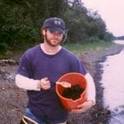
Article
Salmon and Alder as Nitrogen Sources to Riparian Forests in a Boreal Alaskan Watershed
Oecologia
(2002)
Abstract
Anadromous Pacific salmon (Oncorhynchus spp.) transport marine-derived nitrogen (MDN) to the rivers in which they spawn. Isotopic analyses of riparian vegetation in a boreal Alaskan watershed indicate that trees and shrubs near spawning streams derive -24-26% of their foliar nitrogen (N) from salmon. Basal area growth of white spruce (Picea glauca ) is enhanced at sites receiving MDN inputs. This marine N subsidy appears to be less important to riparian ecosystems where symbiotic N fixation by alder (Alnus crispa) is prevalent, although salmon carcasses may nonetheless be an important source of other marine-derived nutrients affecting productivity in these forests. These findings illustrate the complexity of interactions surrounding riparian forests and the interconnectedness of river and riparian ecosystems.
Keywords
- Alnus crispa,
- Marine-derived nutrients,
- Oncorhynchus,
- Picea glauca,
- Riparian,
- Stable isotopes
Disciplines
Publication Date
December, 2002
Publisher Statement
Published by: Springer in cooperation with International Association for Ecology Stable URL: http://www.jstor.org/stable/4223457
Citation Information
James M. Helfield and Robert J Naiman. "Salmon and Alder as Nitrogen Sources to Riparian Forests in a Boreal Alaskan Watershed" Oecologia Vol. 133 Iss. 4 (2002) Available at: http://works.bepress.com/helfield_james/7/
